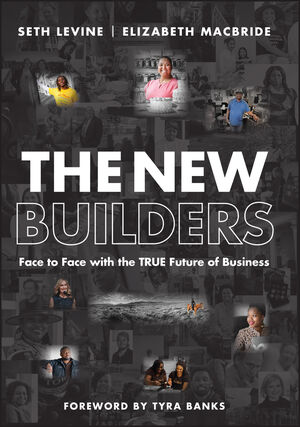The New Builders
- By Seth Levine and Elizabeth MacBride
- Wiley
- 304 pp.
- Reviewed by Darrell Delamaide
- May 28, 2022
Do nontraditional entrepreneurs hold the key to America’s economic success?

The well-written The New Builders deals with the important issue of the additional hurdles faced by minority and women entrepreneurs as it chronicles their ups and downs. Business journalist Elizabeth MacBride and venture capitalist Seth Levine have combined on-the-ground reporting with in-depth research to produce a compelling narrative of the challenges faced by entrepreneurs struggling against racism, sexism, and ageism.
The word “entrepreneur” has taken on a high-tech connotation in the age of Silicon Valley, and the authors want to correct that impression by calling these more typical individuals “new builders,” underscoring the importance of startups and small businesses in powering the economy. These are not tech giants but founders of bakeries, developers tackling blighted parts of town, service providers protecting our wilderness heritage, and numerous others.
Most importantly, the authors insist, they come from all backgrounds and are more essential than ever to fueling economic growth. Young, white, male, Ivy-League alumni have an edge in gaining access to finance and mentoring to launch businesses, but it is entrepreneurs from ethnic minorities, women, and older innovators with a lifetime of experience who can best provide the added boost we need for sustainable growth.
As supermodel-turned-businesswoman Tyra Banks says in a passionate foreword, it’s not enough to hear praise for your ideas or your abilities — it still takes a lot of grit and resilience to get a business started and perseverance to make it a success. For minorities, women, and older entrepreneurs, it takes even more of both.
The authors return repeatedly to these qualities in their case studies as they intersperse their narrative with arresting statistics about the decline of small businesses and the danger it poses for future economic growth, as well as perspective on the historical role of entrepreneurship in developing the American economy.
But the real strength of the book remains the reporting on individual new builders. It opens with Danaris Mazara, who was born in the Dominican Republic and immigrated to the U.S. via Puerto Rico to found the Sweet Grace Heavenly Cakes bakery in Lawrence, Massachusetts, catering primarily to the large Dominican population there.
It then moves on to Steve Murray, whose Zap & Co. antiques store in Lancaster, Pennsylvania, led the way to revitalizing that faded town. Kirsten Quigley, a stay-at-home mom, attacked the dominance of plastic in school-lunch packaging by innovating a paper alternative, so that Lunchskins products are now sold in 3,500 stores, including Whole Foods Markets, Target, and the Container Store.
Quigley exemplifies the authors’ claim that women-owned businesses are the single biggest potential source of economic growth. One difference, this new builder notes, is that the “kitchen table is to women entrepreneurs as the garage is to men: the legendary birthplace of some of the best ideas.”
Sandino Thompson, an Oklahoma City native who worked construction jobs in the Southeast, returned home and partnered with developer Jonathan Dodson to tackle the blighted northeast section of his city. Jill Castilla at Citizens Bank of Edmonton (Oklahoma) was intrigued and defied informal redlining to get them a loan of $2.6 million.
The upshot is that these new builders are important in reinvigorating their communities. They draw strength from them and give back energy. Prosperous, thriving communities are the heartbeat not only of an economy, but of a nation united around common values and common goals.
For all the statistics they bring to bear on the dwindling support for new builders, the authors are perhaps too pessimistic in characterizing the current state of affairs as dire. Their own examples present a contrary narrative, although it is certainly worthwhile to advocate for greater awareness of the hurdles emerging entrepreneurs face, particularly those from disenfranchised classes.
MacBride and Levine mean well, too, in trying to redefine entrepreneurs as “new builders.” The term “entrepreneur” has a certain MEGO quality, but the title and moniker they chose may not be ideal. Those not clued in by, say, a review might think this is a DIY book for Home Depot customers. Language evolves for a reason, and you tinker with it at your own risk.
More fundamentally, packing reporting, statistics, and history all together into a compact narrative makes for a text that is quite dense. It is certainly a worthwhile book but might be tough going for casual readers.
[Editor's note: This review originally ran in 2021.]
Darrell Delamaide is a veteran business journalist based in Washington, DC.
